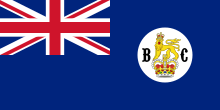United colonies of Vancouver Island and British Columbia
United Colonies of Vancouver Island and British Columbia ( United Colonies of Vancouver Island and British Columbia ) was the informal name for the state structure that was formed from the merger of the colonies of Vancouver Island and British Columbia in 1866 and which continued until it joined the Canadian Confederation in 1871 duration. The capital was Victoria .
history
background
The Vancouver Island colony was established in 1849 to secure British claims to the entire island and the adjacent Gulf Islands . Three years earlier, Great Britain and the United States had agreed in the Oregon Compromise to define the 49th parallel as the limit west of the Rocky Mountains .
The mainland part of what is now the Canadian province of British Columbia (then called New Caledonia) was a legally disorganized territory in British North America before 1858 . The region was de facto under the administration of the Hudson's Bay Company and its branch manager James Douglas , who was also governor of Vancouver Island. With the Fraser Canyon Gold Rush , the non-native population rose from around 150 HBC employees to nearly 20,000 prospectors, speculators, real estate agents and traders in a short period of time. The British Colonial Office reacted quickly and proclaimed the colony of British Columbia on August 2, 1858 .
Fusion of the two colonies
Douglas administered the mainland colony from the city of Victoria on Vancouver Island . It was not until 1864 that a second governor, Frederick Seymour , resided in New Westminster , the then capital of British Columbia. In the same year Arthur replaced Edward Kennedy Douglas as governor of Vancouver Island. Both colonies accumulated large debts, mainly caused by extensive infrastructure projects to cope with rapid population growth. When gold mining revenues fell, interest rates tore a hole in the coffers of the two colonies. The Colonial Office proclaimed the merger on August 6, 1866 and appointed Frederick Seymour governor.
After four colonies merged to form the Canadian Confederation with the entry into force of the British North America Act in 1867 , it seemed only a matter of time before Vancouver Island and British Columbia would begin accession negotiations. Influential members of the Confederation League such as Amor De Cosmos , Robert Beaven and John Robson saw membership as the best way to implement democratic reforms. They were supported by Canadian representatives, above all Samuel Leonard Tilley , Customs Minister in John Macdonald's government . The terminally ill Governor Frederick Seymour was to be replaced by Anthony Musgrave , the outgoing Governor of Newfoundland . Just before the appointment became final, Seymour died in June 1869.
After Musgrave took office, the British Colonial Secretary, Lord Granville , urged him to accelerate negotiations with Canada, which nevertheless took two years to complete. Canada pledged to assume the accumulated debts of the colonies and, within ten years, to build a transcontinental railroad to link British Columbia with the rest of the country. British Columbia finally joined the Canadian Confederation on July 25, 1871 as the sixth province.
Governors
- 1866-1869: Frederick Seymour
- 1869–1871: Anthony Musgrave
Web links
literature
- Jean Barman: The West beyond the West - A History of British Columbia. University of Toronto Press, Toronto 2007. ISBN 0-80209-495-3 .
- Daniel Francis: The Encyclopedia of British Columbia. Harbor Publishing, Pender Harbor 2000. ISBN 1-55017-200-X .
